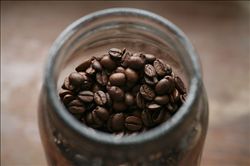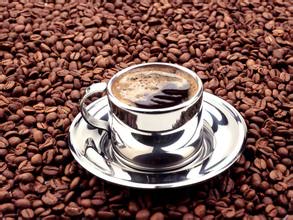The treatment method of half-sun-dried coffee and raw beans
Brazilian half-sun-natural removal of pectin:
Brazil used to use the method of tanning in the past, and there was a big difference in quality, which made Brazil Chongqing synonymous with low-to-middle quality. However, in order to improve its quality and reverse its image, the world's largest coffee producer carried out a quality revolution in the 1990s and vigorously promoted the global half-sun method.
Brazilian coffee fields are endless and are mostly harvested mechanically in order to meet the economic benefits. When 75% of the coffee fruit in the coffee garden turns red, mechanical harvesting is started, followed by the same pre-washing operation, which is moved into the sink to remove floating beans, sift out the sunken beans, and then use a large pulp screening machine to dig out the pulp and remove the pods covered with pectin. The next stage is separate from the washing method: the sticky pods do not need to be moved into the tank to ferment, but to the outdoor bean drying farm. Because of the dry climate in Brazil, the sticky pectin on the pods will harden in about a day or so. Then use a large number of manpower to turn up and down, so that the pods dry evenly inside and outside, so as not to return to moisture and stink. In about two to three days, with the help of the natural force of the sun pass and dry climate, the pods can achieve a certain degree of dehydration. Then further dry with a dryer, the water content is reduced to 10.5%, and the pods are stored in a special container for about 10 days to further mature, in order to stabilize the quality, remove sheep skins (pods) before export, remove coffee beans, and pack them in stages.
Pulped-natural, also known as honey treatment (Miel Process in Spanish), is said to refer to the process of making raw beans that are sun-dried with mucous membranes.
The honey treatment process is vulnerable to pollution and mildew, so it needs to be closely watched throughout the process, constantly turning, and speeding up drying, so as to avoid bad fermentation flavor. Its advantage is that it can best preserve the original sweet flavor of coffee ripe fruit, making the coffee show elegant black sugar flavor and drupe flavor, while the berry flavor also supports the basic aroma of red wine, which is considered to be a very elegant product. The popularity of honey-treated boutique coffee beans is largely due to its sweet and thick characteristics. in recent years, there are more and more boutique coffee beans called "Miel Process", and they have also become the preferred material for international boutique coffee contestants.
4. Mechanical semi-washing-economical and affordable
Not all producing areas can use the Brazilian half-sun method. If the producing area with heavy moisture is allowed to take out the pectin pods and expose them outdoors, it is not only not easy to be dehydrated and hard, but also easy to parasitize molds. Therefore, mechanical semi-washing has been developed in areas with heavy humidity, which saves both labor and water.
First of all, the red fruit and half-green and half-red fruit sunk into the sink into the pulp sieving machine to remove the full pectin, and there is no need to take it to the sun, let alone pour it into the sink to ferment, but directly into the nearby pectin scraper (Demucilager) with a small amount of water, which can mechanically scrape off the sticky pectin shavings, take out the smooth pods, and expose them outdoors until the water content is reduced to 12%.
In addition, there are in vivo fermentation methods, such as Kopi Luwak raw beans are fermented and shelled in civets. Others such as shit coffee, monkey coffee and so on. Water washing method-increase fruit acid spirit:
Water washing is the most popular treatment method at present, and it is used in almost all Central and South America except Brazil. The color of the washed beans is blue and green, the appearance of the beans is neat and the pulse is good, and the coffee quality is the highest. Generally speaking, the sour flavor and bright feeling of washed beans are better, and the flavor is clean and free of miscellaneous flavor, which is the most commonly used treatment of fine coffee, but the cost is not small. On average, it takes 2-10 liters of clean water to wash 1 kilogram of coffee fruit, while 1 kilogram of coffee fruit can only take 200 grams of coffee beans. It is difficult for water-scarce areas to bear such a water-consuming method.
Washing is the most technical way to pick up beans, and the quality of coffee is ensured through multiple sieving procedures. First move the red fruit and half-green and half-red fruit that have sunk into the sink into a large or medium-sized pulp screening machine (PulpingMachines). It is cleverly designed to mechanically press the fruit into a sieve hole, which is exactly the size of the pod (both sheepskin-wrapped coffee beans) to filter out the flesh outside the pod-using unripe fruit to be harder. Pods are not easy to squeeze out, but mature fruits are soft, and pods are easily squeezed out to ward off unripe beans and filter out the sweetest pods, so the setting of machine thrust is very important. too much force will squeeze out hard and astringent unripe beans, damaging the quality of fine beans. The general push force is set to allow 3% of red fruit pods to be squeezed into the sieve hole to ensure that all stiff green fruits are removed.
After taking out the sticky pods of the red fruit, move them into a large sink, followed by the most important washing and fermentation to remove pectin shavings from the pods. This sticky material is not easy to wash away with water, so it is necessary to hydrolyze the pectin with all kinds of bacteria in the tank, decompose the pectin and wash the pods in the tank to accelerate the pectin to break away from the pods. The fermentation process takes about 16 to 36 hours, depending on temperature and humidity, when malic acid is naturally produced in the tank. Citric acid. Acetic acid. Lactic acid and propionic acid. Interestingly, the raw bean itself contains almost no acetic acid, but the fermentation process of washing treatment can increase the acetic acid concentration of the bean, which is beneficial to the flavor of coffee. Not only can these acids inhibit mold parasitism, some acid elves will also be mixed into beans (which is why washed beans taste so sour), but samples must be taken at any time to see if the sticky pectin on the pods is clean, and then decide whether to stop fermentation and take out clean pods. Once it lasts more than 36 minutes, it may ferment too much, producing too many fatty acids and butynic acid and giving off a bad smell. Moreover, beans mixed with too much acid will make coffee too sour and Chongqing is a bad bean!

Important Notice :
前街咖啡 FrontStreet Coffee has moved to new addredd:
FrontStreet Coffee Address: 315,Donghua East Road,GuangZhou
Tel:020 38364473
- Prev

Smooth Guatemalan coffee introduces Atitlan, one of the five major volcanic producing areas.
Coffee was really introduced into Guatemala in 1750 by Father Jesuit, and the coffee industry was developed by German colonists at the end of the 19th century. Today, most of the coffee industry's production takes place in the south of the country. There are seven major coffee producing areas in Guatemala, and the flavor of the coffee produced in each area is different, but to sum up, the coffee in Guatemala is all
- Next

Introduction of boutique coffee beans in the western valley of Tarasu, Costa Rica
Tarasu, Costa Rica, arrazu) is one of the major coffee producing areas in the world, with a light and pure flavor and pleasant aroma. Costa Rica, with its fertile volcanic soil and good drainage, is the first country in Central America to grow coffee and bananas for commercial value. Coffee and bananas are the country's main exports. Extra hard beans are excellent.
Related
- Detailed explanation of Jadeite planting Land in Panamanian Jadeite Manor introduction to the grading system of Jadeite competitive bidding, Red bid, Green bid and Rose Summer
- Story of Coffee planting in Brenka region of Costa Rica Stonehenge Manor anaerobic heavy honey treatment of flavor mouth
- What's on the barrel of Blue Mountain Coffee beans?
- Can American coffee also pull flowers? How to use hot American style to pull out a good-looking pattern?
- Can you make a cold extract with coffee beans? What is the right proportion for cold-extracted coffee formula?
- Indonesian PWN Gold Mandrine Coffee Origin Features Flavor How to Chong? Mandolin coffee is American.
- A brief introduction to the flavor characteristics of Brazilian yellow bourbon coffee beans
- What is the effect of different water quality on the flavor of cold-extracted coffee? What kind of water is best for brewing coffee?
- Why do you think of Rose Summer whenever you mention Panamanian coffee?
- Introduction to the characteristics of authentic blue mountain coffee bean producing areas? What is the CIB Coffee Authority in Jamaica?

